徐思/楊玲《面向物件程式設計(Java)》第十一週學習總結
一、理論知識部分
一般將資料結構分為兩大類:線性資料結構和非線性資料結構。線性資料結構:線性表、棧、佇列、串、陣列和檔案。非線性資料結構:樹和圖。
線性表按其儲存結構可分為順序表和連結串列;用順序儲存結構儲存的線性表稱為順序表;順序表將線性表中的資料元素依次存放在某個儲存區域中。一維陣列就是用順序方式儲存的線性表。用鏈式儲存結構儲存的線性表稱為連結串列。
棧(Stack)也是一種特殊的線性表,是一種後進先出 (LIFO)的結構。棧是限定僅在表尾進行插入和刪除運算的線性表,表尾稱為棧頂(top),表頭稱為棧底(bottom)。棧的物理儲存可以用順序儲存結構,也可以用鏈式儲存結構。
佇列(Queue)是限定所有的插入只能在表的一端進行 ,而所有的刪除都在表的另一端進行的線性表。表中允許插入的一端稱為隊尾(Rear),允許刪除的一端稱為隊頭(Front)。佇列的操作是按先進先出(FIFO)的原則進行的。佇列的物理儲存可以用順序儲存結構,也可以用鏈式儲存結構。
散列表又稱為雜湊表。散列表演算法的基本思想是:以結點的關鍵字為自變數,通過一定的函式關係(雜湊函式)計算出對應的函式值,以這個值作為該結點儲存在散列表中的地址。當散列表中的元素存放太滿,就必須進行再雜湊,將產生一個新的散列表,所有元素存放到新的散列表中,原先的散列表將被刪除。在Java語言中,通過負載因子(load factor)來決定何時對散列表進行再雜湊。負載因子越高 (越接近1.0),記憶體的使用效率越高,元素的尋找時間越長。負載因子越低 (越接近0.0),元素的尋找時間越短,記憶體浪費越多。HashSet類的預設負載因子是0.75。
JAVA的集合框架實現對各種資料結構的封裝,以降低對資料管理與處理的難度。所謂框架就是一個類庫的集合,框架中包含很多超類,程式設計者建立這些超類的子類可較方便的設計設計程式所需的類。
集合框架:JAVA集合類庫的統一架構。
集合類的作用:Java的集合類提供了一些基本資料結構的支援。
集合類的使用: Java的集合類包含在java.util包中。
集合類的特點一:只容納物件。注意:陣列可以容納基本資料型別資料和物件。如果集合類中想使用基本資料型別,又想利用集合類的靈活性,可以把基本資料型別資料封裝成該資料型別的包裝器物件,然後放入集合中處理。
特點二:集合類容納的物件都是Object類的例項,一旦把一個物件置入集合類中,它的類資訊將丟失,這樣設計的目的是為了集合類的通用性。因為Object類是所有類的祖先,所以可以在這些集合中存放任何類的物件而不受限制,但在使用集合成員之前必須對它重新造型。
Vector類類似長度可變的陣列。Vector中只能存放物件。Vector的元素通過下標進行訪問。 Vector類關鍵屬性:capacity表示集合最多能容納的元素個數。capacityIncrement表示每次增加多少容量。size表示集合當前元素個數。
Stack類是Vector的子類。Stack類描述堆疊資料結構,即LIFO。
Hashtable通過鍵來查詢元素。Hashtable用雜湊碼(hashcode)來確定鍵。所有物件都有一個雜湊碼,可以通過Object類的hashCode()方法獲得。
集合框架中的基本介面:Collection:集合層次中的根介面,JDK未提供這個介面的直接實現類。
Set:不能包含重複的元素。物件可能不是按存放的次序存放,也就是說不能像陣列一樣按索引的方式進行訪問,SortedSet是一個按照升序排列元素的Set。
List:是一個有序的集合,可以包含重複的元素。提供了按索引訪問的方式。
Map:包含了key-value對。Map不能包含重複的key。
SortedMap是一個按照升序排列key的Map。
Collection介面:構造類集框架的基礎。
List的明顯特徵是它的元素都有一個確定的順序。實現它的類有ArrayList和LinkedList。ArrayList中的元素在記憶體中是順序儲存的。LinkedList中的元素在記憶體中是以連結串列方式儲存的。
ArrayList:可以將其看作是能夠自動增長容量的陣列。利用ArrayList的toArray()返回一個數組。Arrays.asList()返回一個列表。LinkedList是採用雙向迴圈連結串列實現的。利用LinkedList實現棧(stack)、佇列(queue)、雙向佇列 (double-ended queue )。ArrayList底層採用陣列完成,而LinkedList則是以一般的雙向連結串列(double-linked list)完成,其內每個物件除了資料本身外,還有兩個引用,分別指向前一個元素和後一個元素。如果經常在 List 中進行插入和刪除操作,應該使用LinkedList,否則,使用ArrayList將更加快速。
Set中的元素必須唯一。新增到Set中的物件元素必須定義equals方法,以提供演算法來判斷欲新增進來的物件是否與已經存在的某物件相等,從而建立物件的唯一性。實現Set介面的類有HashSet,TreeSet。
TreeSet是一個有序集合,TreeSet中元素將按照升序排列,預設是按照自然順序進行排列,意味著TreeSet中元素要實現Comparable介面。可以在構造TreeSet物件時,傳遞實現了 Comparator介面的比較器物件。HashSet是基於Hash演算法實現的,其效能通常都優於TreeSet。通常使用HashSet,需要排序的功能時,使用TreeSet。
Map介面用來維持很多“鍵-值”對,以便通過鍵來查詢相應的值。HashMap基於散列表實現(替代Hashtable)。TreeMap在一個二叉樹的基礎上實現。
對映(map)是一個儲存關鍵字和值的關聯或關鍵字/值對的物件。給定一個關鍵字,可以得到它的值。關鍵字和值都是物件。關鍵字必須是唯一的。但值是可以被複制的。
Map介面對映唯一關鍵字到值。關鍵字(key)是以後用於檢索值的物件。給定一個關鍵字和一個值,可以儲存這個值到一個Map物件中。當這個值被儲存以後,就可以使用它的關鍵字來檢索它
Map迴圈使用兩個基本操作:get( )和put( )。使用 put( )方法可以將一個指定了關鍵字和值的值加入對映。為了得到值,可以通過將關鍵字作為引數來呼叫 get( )方法。呼叫返回該值。
Map介面的實現類主要有HashMap,TreeMap,Hashtable,Properties。HashMap對key進行雜湊。TreeMap按照key進行排序。和Set類似,HashMap的速度通常都比TreeMap快,只有在需要排序的功能的時候,才使用TreeMap。
二、實驗部分
1、實驗目的與要求
(1) 掌握Vetor、Stack、Hashtable三個類的用途及常用API;
(2) 瞭解java集合框架體系組成;
(3) 掌握ArrayList、LinkList兩個類的用途及常用API。
(4) 瞭解HashSet類、TreeSet類的用途及常用API。
(5)瞭解HashMap、TreeMap兩個類的用途及常用API;
(6) 結對程式設計(Pair programming)練習,體驗程式開發中的兩人合作。
2、實驗內容和步驟
實驗1: 匯入第9章示例程式,測試程式並進行程式碼註釋。
測試程式1:
l 使用JDK命令執行編輯、執行以下三個示例程式,結合執行結果理解程式;
l 掌握Vetor、Stack、Hashtable三個類的用途及常用API。
| //示例程式1 import java.util.Vector;
class Cat { private int catNumber;
Cat(int i) { catNumber = i; }
void print() { System.out.println("Cat #" + catNumber); } }
class Dog { private int dogNumber;
Dog(int i) { dogNumber = i; }
void print() { System.out.println("Dog #" + dogNumber); } }
public class CatsAndDogs { public static void main(String[] args) { Vector cats = new Vector(); for (int i = 0; i < 7; i++) cats.addElement(new Cat(i)); cats.addElement(new Dog(7)); for (int i = 0; i < cats.size(); i++) ((Cat) cats.elementAt(i)).print(); } } |
| //示例程式2 import java.util.*;
public class Stacks { static String[] months = { "1", "2", "3", "4" };
public static void main(String[] args) { Stack stk = new Stack(); for (int i = 0; i < months.length; i++) stk.push(months[i]); System.out.println(stk); System.out.println("element 2=" + stk.elementAt(2)); while (!stk.empty()) System.out.println(stk.pop()); } } |
| //示例程式3 import java.util.*;
class Counter { int i = 1;
public String toString() { return Integer.toString(i); } }
public class Statistics { public static void main(String[] args) { Hashtable ht = new Hashtable(); for (int i = 0; i < 10000; i++) { Integer r = new Integer((int) (Math.random() * 20)); if (ht.containsKey(r)) ((Counter) ht.get(r)).i++; else ht.put(r, new Counter()); } System.out.println(ht); } } |

//示例程式1 import java.util.Vector; class Cat { private int catNumber; Cat(int i) { catNumber = i; } void print() { System.out.println("Cat #" + catNumber); } } class Dog { private int dogNumber; Dog(int i) { dogNumber = i; } void print() { System.out.println("Dog #" + dogNumber); } } import java.util.Vector; public class CatsAndDogs { public static void main(String[] args) { Vector cats = new Vector(); for (int i = 0; i < 7; i++) cats.addElement(new Cat(i)); cats.addElement(new Dog(7)); for (int i = 0; i < cats.size(); i++) { if (cats.elementAt(i) instanceof Cat) { ((Cat) cats.elementAt(i)).print(); } else { ((Dog) cats.elementAt(i)).print(); } } } }
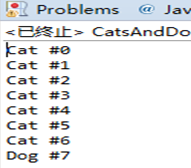


測試程式2:
l 使用JDK命令編輯執行ArrayListDemo和LinkedListDemo兩個程式,結合程式執行結果理解程式;
| import java.util.*;
public class ArrayListDemo { public static void main(String[] argv) { ArrayList al = new ArrayList(); // Add lots of elements to the ArrayList... al.add(new Integer(11)); al.add(new Integer(12)); al.add(new Integer(13)); al.add(new String("hello")); // First print them out using a for loop. System.out.println("Retrieving by index:"); for (int i = 0; i < al.size(); i++) { System.out.println("Element " + i + " = " + al.get(i)); } } } |
| import java.util.*; public class LinkedListDemo { public static void main(String[] argv) { LinkedList l = new LinkedList(); l.add(new Object()); l.add("Hello"); l.add("zhangsan"); ListIterator li = l.listIterator(0); while (li.hasNext()) System.out.println(li.next()); if (l.indexOf("Hello") < 0) System.err.println("Lookup does not work"); else System.err.println("Lookup works"); } } |


l 在Elipse環境下編輯執行除錯教材360頁程式9-1,結合程式執行結果理解程式;
l 掌握ArrayList、LinkList兩個類的用途及常用API。
package linkedList; import java.util.*; /** * This program demonstrates operations on linked lists. * * @version 1.11 2012-01-26 * @author Cay Horstmann */ public class LinkedListTest { public static void main(String[] args) { List<String> a = new LinkedList<>(); a.add("Amy"); a.add("Carl"); a.add("Erica"); List<String> b = new LinkedList<>(); b.add("Bob"); b.add("Doug"); b.add("Frances"); b.add("Gloria"); // merge the words from b into a ListIterator<String> aIter = a.listIterator(); Iterator<String> bIter = b.iterator(); while (bIter.hasNext()) { if (aIter.hasNext()) aIter.next(); aIter.add(bIter.next()); } System.out.println(a); // remove every second word from b bIter = b.iterator(); while (bIter.hasNext()) { bIter.next(); // skip one element if (bIter.hasNext()) { bIter.next(); // skip next element bIter.remove(); // remove that element } } System.out.println(b); // bulk operation: remove all words in b from a a.removeAll(b); System.out.println(a); } }

測試程式3:
l 執行SetDemo程式,結合執行結果理解程式;
| import java.util.*; public class SetDemo { public static void main(String[] argv) { HashSet h = new HashSet(); //也可以 Set h=new HashSet() h.add("One"); h.add("Two"); h.add("One"); // DUPLICATE h.add("Three"); Iterator it = h.iterator(); while (it.hasNext()) { System.out.println(it.next()); } } } |
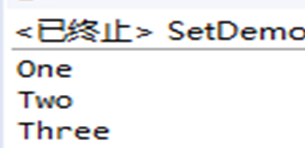
l 在Elipse環境下除錯教材365頁程式9-2,結合執行結果理解程式;瞭解HashSet類的用途及常用API。
package set; import java.util.*; /** * This program uses a set to print all unique words in System.in. * * @version 1.12 2015-06-21 * @author Cay Horstmann */ public class SetTest { public static void main(String[] args) { Set<String> words = new HashSet<>(); // HashSet implements Set long totalTime = 0; try (Scanner in = new Scanner(System.in)) { while (in.hasNext()) { String word = in.next(); long callTime = System.currentTimeMillis(); words.add(word); callTime = System.currentTimeMillis() - callTime; totalTime += callTime; } } Iterator<String> iter = words.iterator(); for (int i = 1; i <= 20 && iter.hasNext(); i++) System.out.println(iter.next()); System.out.println(". . ."); System.out.println(words.size() + " distinct words. " + totalTime + " milliseconds."); } }

l 在Elipse環境下除錯教材367頁-368程式9-3、9-4,結合程式執行結果理解程式;瞭解TreeSet類的用途及常用API。
package treeSet; import java.util.*; /** * This program sorts a set of item by comparing their descriptions. * * @version 1.12 2015-06-21 * @author Cay Horstmann */ public class TreeSetTest { public static void main(String[] args) { SortedSet<Item> parts = new TreeSet<>(); parts.add(new Item("Toaster", 1234)); parts.add(new Item("Widget", 4562)); parts.add(new Item("Modem", 9912)); System.out.println(parts); NavigableSet<Item> sortByDescription = new TreeSet<>(Comparator.comparing(Item::getDescription)); sortByDescription.addAll(parts); System.out.println(sortByDescription); } }
package treeSet; import java.util.*; /** * An item with a description and a part number. */ public class Item implements Comparable<Item> { private String description; private int partNumber; /** * Constructs an item. * * @param aDescription the item's description * @param aPartNumber the item's part number */ public Item(String aDescription, int aPartNumber) { description = aDescription; partNumber = aPartNumber; } /** * Gets the description of this item. * * @return the description */ public String getDescription() { return description; } public String toString() { return "[description=" + description + ", partNumber=" + partNumber + "]"; } public boolean equals(Object otherObject) { if (this == otherObject) return true; if (otherObject == null) return false; if (getClass() != otherObject.getClass()) return false; Item other = (Item) otherObject; return Objects.equals(description, other.description) && partNumber == other.partNumber; } public int hashCode() { return Objects.hash(description, partNumber); } public int compareTo(Item other) { int diff = Integer.compare(partNumber, other.partNumber); return diff != 0 ? diff : description.compareTo(other.description); } }

測試程式4:
l 使用JDK命令執行HashMapDemo程式,結合程式執行結果理解程式;
| import java.util.*; public class HashMapDemo { public static void main(String[] argv) { HashMap h = new HashMap(); // The hash maps from company name to address. h.put("Adobe", "Mountain View, CA"); h.put("IBM", "White Plains, NY"); h.put("Sun", "Mountain View, CA"); String queryString = "Adobe"; String resultString = (String)h.get(queryString); System.out.println("They are located in: " + resultString); } } |

l 在Elipse環境下除錯教材373頁程式9-6,結合程式執行結果理解程式;
l 瞭解HashMap、TreeMap兩個類的用途及常用API。
package map; import java.util.*; /** * This program demonstrates the use of a map with key type String and value * type Employee. * * @version 1.12 2015-06-21 * @author Cay Horstmann */ public class MapTest { public static void main(String[] args) { Map<String, Employee> staff = new HashMap<>(); staff.put("144-25-5464", new Employee("Amy Lee")); staff.put("567-24-2546", new Employee("Harry Hacker")); staff.put("157-62-7935", new Employee("Gary Cooper")); staff.put("456-62-5527", new Employee("Francesca Cruz")); // print all entries System.out.println(staff); // remove an entry staff.remove("567-24-2546"); // replace an entry staff.put("456-62-5527", new Employee("Francesca Miller")); // look up a value System.out.println(staff.get("157-62-7935")); // iterate through all entries staff.forEach((k, v) -> System.out.println("key=" + k + ", value=" + v)); } }
package map; /** * A minimalist employee class for testing purposes. */ public class Employee { private String name; private double salary; /** * Constructs an employee with $0 salary. * * @param n the employee name */ public Employee(String name) { this.name = name; salary = 0; } public String toString() { return "[name=" + name + ", salary=" + salary + "]"; } }

實驗2:結對程式設計練習:
l 關於結對程式設計的闡述可參見以下連結:
http://www.cnblogs.com/xinz/archive/2011/08/07/2130332.html
http://en.wikipedia.org/wiki/Pair_programming
l 對於結對程式設計中程式碼設計規範的要求參考:
http://www.cnblogs.com/xinz/archive/2011/11/20/2255971.html
以下實驗,就讓我們來體驗一下結對程式設計的魅力。
l 確定本次實驗結對程式設計合作伙伴;
l 各自執行合作伙伴實驗九程式設計練習1,結合使用體驗對所執行程式提出完善建議;
package ID; import java.io.BufferedReader; import java.io.File; import java.io.FileInputStream; import java.io.FileNotFoundException; import java.io.IOException; import java.io.InputStreamReader; import java.util.ArrayList; import java.util.Arrays; import java.util.Collections; import java.util.Scanner; public class Main { private static ArrayList<Person> Personlist; public static void main(String[] args) { Personlist = new ArrayList<>(); Scanner scanner = new Scanner(System.in); File file = new File("身份證號.txt"); try { FileInputStream fis = new FileInputStream(file); BufferedReader in = new BufferedReader(new InputStreamReader(fis)); String temp = null; while ((temp = in.readLine()) != null) { Scanner linescanner = new Scanner(temp); linescanner.useDelimiter(" "); String name = linescanner.next(); String ID = linescanner.next(); String sex = linescanner.next(); String age = linescanner.next(); String place = linescanner.nextLine(); Person Person = new Person(); Person.setname(name); Person.setID(ID); Person.setsex(sex); int a = Integer.parseInt(age); Person.setage(a); Person.setbirthplace(place); Personlist.add(Person); } } catch (FileNotFoundException e) { System.out.println("查詢不到資訊"); e.printStackTrace(); } catch (IOException e) { System.out.println("資訊讀取有誤"); e.printStackTrace(); } boolean isTrue = true; while (isTrue) { System.out.println("————————————————————————————————————————"); System.out.println("1:按姓名字典序輸出人員資訊"); System.out.println("2:查詢最大年齡與最小年齡人員資訊"); System.out.println("3:按省份找同鄉"); System.out.println("4:輸入你的年齡,查詢年齡與你最近人的資訊"); System.out.println("5:exit"); int nextInt = scanner.nextInt(); switch (nextInt) { case 1: Collections.sort(Personlist); System.out.println(Personlist.toString()); break; case 2: int max = 0, min = 100; int j, k1 = 0, k2 = 0; for (int i = 1; i < Personlist.size(); i++) { j = Personlist.get(i).getage(); if (j > max) { max = j; k1 = i; } if (j < min) { min = j; k2 = i; } } System.out.println("年齡最大:" + Personlist.get(k1)); System.out.println("年齡最小:" + Personlist.get(k2)); break; case 3: System.out.println("place?"); String find = scanner.next(); String place = find.substring(0, 3); String place2 = find.substring(0, 3); for (int i = 0; i < Personlist.size(); i++) { if (Personlist.get(i).getbirthplace().substring(1, 4).equals(place)) System.out.println("maybe is " + Personlist.get(i)); } break; case 4: System.out.println("年齡:"); int yourage = scanner.nextInt(); int near = agenear(yourage); int d_value = yourage - Personlist.get(near).getage(); System.out.println("" + Personlist.get(near)); /* * for (int i = 0; i < Personlist.size(); i++) { int * p=Personlist.get(i).getage()-yourage; if(p<0) p=-p; if(p==d_value) * System.out.println(Personlist.get(i)); } */ break; case 5: isTrue = false; System.out.println("退出程式!"); break; default: System.out.println("輸入有誤"); } } } public static int agenear(int age) { int j = 0, min = 53, d_value = 0, k = 0; for (int i = 0; i < Personlist.size(); i++) { d_value = Personlist.get(i).getage() - age; if (d_value < 0) d_value = -d_value; if (d_value < min) { min = d_value; k = i; } } return k; } }
package ID; public class Person implements Comparable<Person> { private String name; private String ID; private int age; private String sex; private String birthplace; public String getname() { return name; } public void setname(String name) { this.name = name; } public String getID() { return ID; } public void setID(String ID) { this.ID = ID; } public int getage() { return age; } public void setage(int age) { // int a = Integer.parseInt(age); this.age = age; } public String getsex() { return sex; } public void setsex(String sex) { this.sex = sex; } public String getbirthplace() { return birthplace; } public void setbirthplace(String birthplace) { this.birthplace = birthplace; } public int compareTo(Person o) { return this.name.compareTo(o.getname()); } public String toString() { return name + "\t" + sex + "\t" + age + "\t" + ID + "\t" + birthplace + "\n"; } }

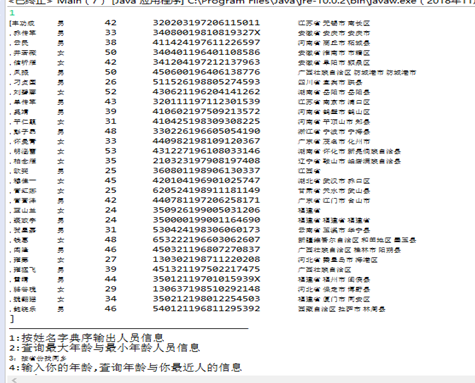
l 各自執行合作伙伴實驗十程式設計練習2,結合使用體驗對所執行程式提出完善建議;
import java.io.FileNotFoundException; import java.io.PrintWriter; import java.util.Scanner; /* * 該程式用來隨機生成0到100以內的加減乘除題 */ public class Demo { public static void main(String[] args) { // 使用者的答案要從鍵盤輸入,因此需要一個鍵盤輸入流 Scanner in = new Scanner(System.in); Counter counter = new Counter(); PrintWriter out = null; try { out = new PrintWriter("text.txt"); } catch (FileNotFoundException e) { // TODO Auto-generated catch block e.printStackTrace(); } // 定義一個變數用來統計得分 int sum = 0; int k = 0; // 通過迴圈生成10道題 for (int i = 0; i < 10; i++) { // 隨機生成兩個100以內的隨機數作加減乘除 int a = (int) Math.round(Math.random() * 100); int b = (int) Math.round(Math.random() * 100); int d = (int) Math.round(Math.random() * 3); switch (d) { case 0: if (a % b == 0) { System.out.println(a + "/" + b + "="); break; } // int c = in.nextInt(); // out.println(a + "/" + b + "="+c); case 1: System.out.println(a + "*" + b + "="); // int c1 = in.nextInt(); // out.println(a + "*" + b + "="+c1); break; case 2: System.out.println(a + "+" + b + "="); // int c2 = in.nextInt(); // out.println(a + "+" + b + "="+c2); break; case 3: if (a > b) { System.out.println(a + "-" + b + "="); break; } // int c3 = in.nextInt(); // out.println(a + "-" + b + "="+c3); } // 定義一個整數用來接收使用者輸入的答案 double c = in.nextDouble(); // 判斷使用者輸入的答案是否正確,正確給10分,錯誤不給分 if (c == a / b | c == a * b | c == a + b | c == a - b) { sum += 10; System.out.println("恭喜答案正確"); } else { System.out.println("抱歉,答案錯誤"); } out.println(a + "/" + b + "=" + c); out.println(a + "*" + b + "=" + c); out.println(a + "+" + b + "=" + c); out.println(a + "-" + b + "=" + c); } // 輸出使用者的成績 System.out.println("你的得分為" + sum); out.println("成績:" + sum); out.close(); } }
public class Counter { private int a; private int b; public int add(int a, int b) { return a + b; } public int reduce(int a, int b) { return a - b; } public int multiplication(int a, int b) { return a * b; } public int division(int a, int b) { if (b != 0) return a / b; else return 0; } }
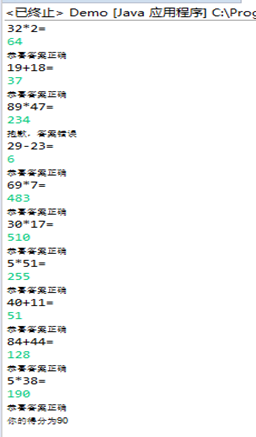
l 採用結對程式設計方式,與學習夥伴合作完成實驗九程式設計練習1;
package ID; import java.io.BufferedReader; import java.io.File; import java.io.FileInputStream; import java.io.FileNotFoundException; import java.io.IOException; import java.io.InputStreamReader; import java.util.ArrayList; import java.util.Arrays; import java.util.Collections; import java.util.Scanner; public class Main { private static ArrayList<Person> Personlist; public static void main(String[] args) { Personlist = new ArrayList<>(); Scanner scanner = new Scanner(System.in); File file = new File("身份證號.txt"); try { FileInputStream fis = new FileInputStream(file); BufferedReader in = new BufferedReader(new InputStreamReader(fis)); String temp = null; while ((temp = in.readLine()) != null) { Scanner linescanner = new Scanner(temp); linescanner.useDelimiter(" "); String name = linescanner.next(); String ID = linescanner.next(); String sex = linescanner.next(); String age = linescanner.next(); String place = linescanner.nextLine(); Person Person = new Person(); Person.setname(name); Person.setID(ID); Person.setsex(sex); int a = Integer.parseInt(age); Person.setage(a); Person.setbirthplace(place); Personlist.add(Person); } } catch (FileNotFoundException e) { System.out.println("查詢不到資訊"); e.printStackTrace(); } catch (IOException e) { System.out.println("資訊讀取有誤"); e.printStackTrace(); } boolean isTrue = true; while (isTrue) { System.out.println("1:按姓名字典序輸出人員資訊"); System.out.println("2:查詢最大年齡與最小年齡人員資訊"); System.out.println("3:按省份找同鄉"); System.out.println("4:輸入你的年齡,查詢年齡與你最近人的資訊"); System.out.println("5:exit"); int nextInt = scanner.nextInt(); switch (nextInt) { case 1: Collections.sort(Personlist); System.out.println(Personlist.toString()); break; case 2: int max = 0, min = 100; int j, k1 = 0, k2 = 0; for (int i = 1; i < Personlist.size(); i++) { j = Personlist.get(i).getage(); if (j > max) { max = j; k1 = i; } if (j < min) { min = j; k2 = i; } } System.out.println("年齡最大:" + Personlist.get(k1)); System.out.println("年齡最小:" + Personlist.get(k2)); break; case 3: System.out.println("place?"); String find = scanner.next(); String place = find.substring(0, 3); String place2 = find.substring(0, 3); for (int i = 0; i < Personlist.size(); i++) { if (Personlist.get(i).getbirthplace().substring(1, 4).equals(place)) System.out.println("maybe is " + Personlist.get(i)); } break; case 4: System.out.println("年齡:"); int yourage = scanner.nextInt(); int near = agenear(yourage); int d_value = yourage - Personlist.get(near).getage(); System.out.println("" + Personlist.get(near)); /* * for (int i = 0; i < Personlist.size(); i++) { int * p=Personlist.get(i).getage()-yourage; if(p<0) p=-p; if(p==d_value) * System.out.println(Personlist.get(i)); } */ break; case 5: isTrue = false; System.out.println("退出程式!"); break; default: System.out.println("輸入有誤"); } } } public static int agenear(int age) { int j = 0, min = 53, d_value = 0, k = 0; for (int i = 0; i < Personlist.size(); i++) { d_value = Personlist.get(i).getage() - age; if (d_value < 0) d_value = -d_value; if (d_value < min) { min = d_value; k = i; } } return k; } }
package ID; public class Person implements Comparable<Person> { private String name; private String ID; private int age; private String sex; private String birthplace; public String getname() { return name; } public void setname(String name) { this.name = name; } public String getID() { return ID; } public void setID(String ID) { this.ID = ID; } public int getage() { return age; } public void setage(int age) { // int a = Integer.parseInt(age); this.age = age; } public String getsex() { return sex; } public void setsex(String sex) { this.sex = sex; } public String getbirthplace() { return birthplace; } public void setbirthplace(String birthplace) { this.birthplace = birthplace; } public int compareTo(Person o) { return this.name.compareTo(o.getname()); } public String toString() { return name + "\t" + sex + "\t" + age + "\t" + ID + "\t" + birthplace + "\n"; } }

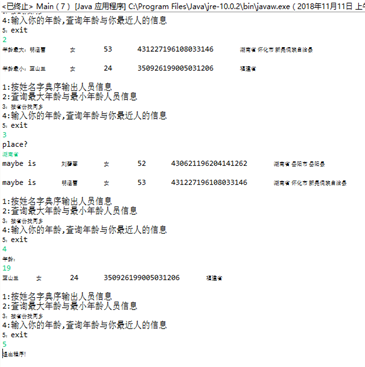
l 採用結對程式設計方式,與學習夥伴合作完成實驗十程式設計練習2。
import java.io.*; import java.io.PrintWriter; import java.util.Scanner; public class Main { public static void main(String[] args) { Scanner in = new Scanner(System.in); PrintWriter output = null; try { output = new PrintWriter("text.txt"); } catch (FileNotFoundException e) { // TODO Auto-generated catch block e.printStackTrace(); } int sum = 0; for (int i = 1; i <= 10; i++) { int a = (int) Math.round(Math.random() * 100); int b = (int) Math.round(Math.random() * 100); int m = (int) Math.round(Math.random() * 4); switch (m) { case 1: while (b == 0) { b = (int) Math.round(Math.random() * 100); } while (a % b != 0) { a = (int) Math.round(Math.random() * 100); } System.out.println(i + ": " + a + "/" + b + "="); int c1 = in.nextInt(); output.println(a + "/" + b + "=" + c1); if (c1 == a / b) { System.out.println("恭喜答案正確"); sum += 10; } else { System.out.println("抱歉,答案錯誤"); } break; case 2: System.out.println(i + ": " + a + "*" + b + "="); int c2 = in.nextInt(); output.println(a + "*" + b + "=" + c2); if (c2 == a * b) { System.out.println("恭喜答案正確"); sum += 10; } else { System.out.println("抱歉,答案錯誤"); } break; case 3: System.out.println(i + ": " + a + "+" + b + "="); int c3 = in.nextInt(); output.println(a + "+" + b + "=" + c3); if (c3 == a + b) { System.out.println("恭喜答案正確"); sum += 10; } else { System.out.println("抱歉,答案錯誤"); } break; case 4: while (a < b) { a = (int) Math.round(Math.random() * 100); } System.out.println(i + ": " + a + "-" + b + "="); int c4 = in.nextInt(); output.println(a + "-" + b + "=" + c4); if (c4 == a - b) { System.out.println("恭喜答案正確"); sum += 10; } else { System.out.println("抱歉,答案錯誤"); } break; } } System.out.println("成績" + sum); output.println("成績" + sum); output.close(); } }
public class math<T> { private T a; private T b; public int add(int a, int b) { return a + b; } public int reduce(int a, int b) { return a - b; } public int multiplication(int a, int b) { return a * b; } public int division(int a, int b) { if (b != 0 && a % b == 0) return a / b; else return 0; } }
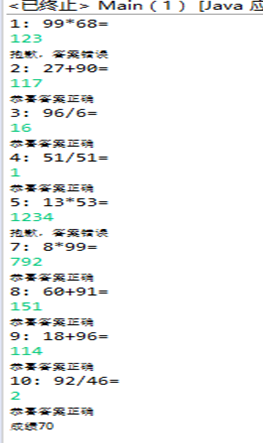
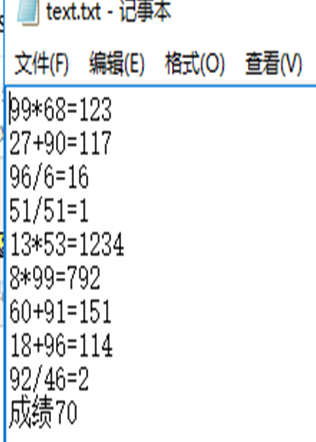
三:實驗總結
通過這次實驗,我瞭解了Vetor、Stack、Hashtable三個類的用途,ArrayList、LinkList兩個類的用途,HashSet類的用途,TreeSet類的用途,HashMap、TreeMap兩個類的用途。通過結對程式設計,和自己的合作伙伴一起討論程式設計,互相學習,對學習Java有很大的幫助。
